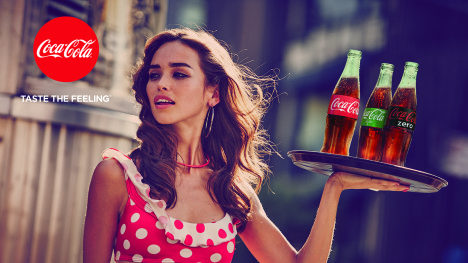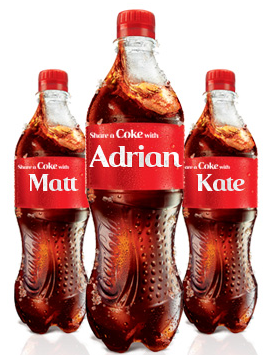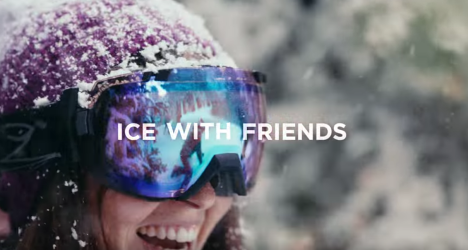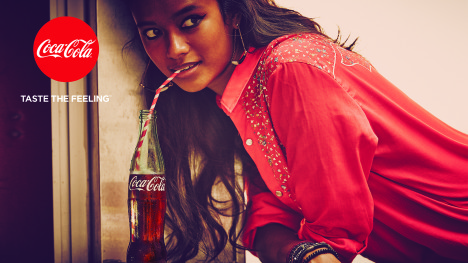Coca-Cola’s new global strategy will move the brand backwards in Australia
 Coca-Cola has created some of the best ad campaigns in Australia in recent years, which makes the decision to run bland global creative all the more bizarre argues Mumbrella’s Alex Hayes.
Coca-Cola has created some of the best ad campaigns in Australia in recent years, which makes the decision to run bland global creative all the more bizarre argues Mumbrella’s Alex Hayes.
Every time I see a case study video about one of the Coke campaigns it starts with a line like “64 per cent of Australian teens don’t drink Coke” or “Coca-Cola was no longer deeply connecting with Australians”.
It’s a brand that needs to reinvent to stay relevant, and it’s beyond me how introducing generic global creative will do that.
Coca-Cola has made a lot of noise about its new brand strategy – and as my colleague Tim Burrowes is so fond of repeating the best number of brands is one. So rolling its less popular products under the banner of the big red one seems like a sensible ploy.
 It seems sales of the lower-kilojoule Coke Life – described as the “spork of drinks” in this great analysis by economist Jason Murphy – aren’t exactly booming either (although Coca-Cola will probably protest otherwise). So why not let it borrow a bit of the equity from the full-fat version?
It seems sales of the lower-kilojoule Coke Life – described as the “spork of drinks” in this great analysis by economist Jason Murphy – aren’t exactly booming either (although Coca-Cola will probably protest otherwise). So why not let it borrow a bit of the equity from the full-fat version?
The problem is they’re supporting it with a global advertising campaign that is at best bland, inoffensive wallpaper, and at worst, meaningless for the brand in Australia.
Initially they are going to use three of the six video ads revealed so far shown in the Australian market.
Here’s the official Coke blurb for each one.
First is ‘Anthem’, created by Mercado-McCann (Buenos Aires, Argentina).
The campaign’s lead spot, “Anthem” features a series of vignettes that capture life’s everyday moments – such as ice-skating and hanging out with friends, a first date, a first kiss, and a first love – all linked by Coca-Cola with the new tagline, “Taste the Feeling.” The spot introduces an original song, “Taste the Feeling” featuring Conrad Sewell that celebrates the experience of drinking a Coca-Cola, any Coca-Cola.
https://youtu.be/-AmKP9VE2Ms?t=8
Encouraging people to share “ice with friends” is surely just asking for trouble.
The same goes for the second spot ‘Brotherly Love’ created by Santo – again from Buenos Aires.
“Brotherly Love” captures the unique relationship between brothers, a universal story of love and conflict. Ultimately the younger brother finds himself without his Coca-Cola. The older brother comes to his rescue and they enjoy a special moment together. The spot features a new version of the hit song “Hey Brother” by Avicii..
https://www.youtube.com/watch?v=0oYlOBun8UI
There are some nice touches in it and it’s the most engaging of the three for me, but the problem lies in quite how universal the “universal story of love and conflict” is.
And lastly we have ‘Break Up’, again created by Santo.
“Break Up” follows the journey of a young couple who romance each other, experience a break up and ultimately reconcile with Coca-Cola playing an intimate role at each stage of the relationship. The spot features the song “Made for You” with vocals by emerging artist Alexander Cardinale.
https://www.youtube.com/watch?v=_xp2T_TooF0
I hope this couple have a good dentist, they drink way too much Coke, and at some really inappropriate moments.
I’m actually gutted they’re not bringing the ‘What is Coca-Cola?’ spot here – if only for the opportunity to laugh regularly at some terrible lip synching.
https://www.youtube.com/watch?v=hlMFkdrnscM
I asked Lisa Winn, Coca-Cola South Pacific marketing director whether she thought the generic global advertising would resonate with Australians.
Her reply, emailed through Coca-Cola’s PR agency Adhesive was:
Yes, absolutely. Our creative uses universal storytelling around human moments, from heartbreak to sibling rivalry it has elements of everyday life that are entirely relatable to an Australian market.”
And they do all tell a story well. They have inspirational soundtracks and aspirational ‘everyday’ themes. But there’s something missing.
They’re stories we’ve heard a thousand times before, and they all really feel like they’ve been produced for somewhere else in the world and then transplanted here at the last minute, even if Winn says they have been “developed with our market in mind”.
Ultimately they’re highly skippable for the Youtube generation they’re targeting. At best they’re watch-once and move on content.
 It’s sad to see the homogenisation of a marketer which locally has brought us Share a Coke and Colour Your Summer – two genuinely bold and effective campaigns.
It’s sad to see the homogenisation of a marketer which locally has brought us Share a Coke and Colour Your Summer – two genuinely bold and effective campaigns.
Share a Coke – putting people’s names on Coke cans – was hailed at the time as the brand taking a big risk by forgoing its logo – but has been transplanted across the globe since.
I asked then Coke’s top marketer Jonathan Mildenhall about the campaign in 2013 and he said he put it in his top three in his time at the brand.
He went on to add: “I respect it because it’s challenged a lot of our perceived ideas about what we could do with our brand, with packaging etc, so when I first saw the idea I was very positive about it because I thought it was very disruptive.
“Then you see the campaign scale all over the world and you realise this is the most successful campaign Coca Cola may have done in decades in terms of proving the correlation between effectiveness and creativity and the commercial impact of outstanding creativity.”
Praise indeed.
Colour Your Summer was arguable even more radical, changing the colour of the cans from red to pink, blue, green and so on was a big move for the master brand, and if the UM case study is to be believed it struck a chord with teens with some clever use of media and won Best Media Campaign at last year’s Mumbrella Awards.
In the same emailed responses Winn said they would continue to work with their local agencies, which include Ogilvy, Urban and UM and she claimed: “Our local agencies are better networked than ever before and even today are leading some global projects of our brands.”
But from this morning’s Australian press release it appears they will mostly be limited to repurposing the international stuff – an unexciting prospect for any creative – and experiential campaigns.
Experiential has been a big part of Coke’s marketing in recent years. But since Share a Coke those haven’t all run as smoothly as they would want.
Remember the Sprite Showers which were pulled down after being built at Bondi after the Cash For Containers policy was approved last year? Or the attack of the Penguin protesters at its big reveal during its shipping container competition in Circular Quay in 2013?
They’ve always been supported with above the line, so it may be we see more local creativity around the all important summer campaigns. We’ll probably have to wait 11 months to find out.
I’ll leave it to others to dissect the decision to change the tagline from ‘Open happiness’ to ‘Taste the feeling’ – although it has raised more questions than answers so far.
The best element of the campaign is the print work, with the “Norman Rockwell Meets Instagram” style even popping on a computer screen.
It seems with this decision Coca-Cola is eschewing any chance of controversy and playing it incredibly safe. That’s really disappointing for a brand which has led global advertising for the last 100 years.
But by doing so they’re also risking slipping further into irrelevance – substituting talkable content for banal wallpaper.
Annoyingly some of these spots will probably pick up some metal at awards shows. But as we’ve established by now the real test will be whether they shift more sugar water to the masses in Australia and across the world.
- Alex Hayes is editor of Mumbrella








The campaign isn’t much more than chewing gum for the eyes but to be frank if you’re trying to maintain the prestige in a global brand you need to have global branding.
“Taste the feeling” is odd. Personally I think it works better as “Feeling the taste”.
User ID not verified.
I wouldn’t be bothered with this. If you use anything and everything that Coke is associated with. Take the Motorhead lead man Lemmy Kilmister. Has only recently left the physical plane to learn ‘the big secret’. He drank Jack and Coke… Instead of having Coke the as the stand alone hero why not associate Coke with the relative people and products… Do we have to spoon feed the creatives? It’s not only the young. Over 280,000 memorial views, most of these venues with some 200 plus… All of them drinking JD & Coke. No Coke inspired advertising just a mans habit becoming in vogue. Associate with other brands, and move ahead.
User ID not verified.
Agree the print is the saving grace for the campaign and will extend into outdoor.
TVCs are rank and that’s being kind. Can always smell BS spin when ‘storytelling’ and ‘moments’ are used in the same sentence.
User ID not verified.
Does it annoy anyone else that the coke bottle never has a lid on? In the ‘couple’ video the girl is even walking around with it in her back pocket opened
User ID not verified.
Has this got anything to do with it being an Olympic year — and as a major sponsor Coca Cola will be looking to use a globally aligned message and brand that will be seen across all ‘stateless media’?
User ID not verified.
Timely use of David Bowie and Queen’s “Under Pressure”. They will be back to local campaigns next summer.
User ID not verified.
I really love “taste the feeling” – i think that’s really powerful and evocative.
User ID not verified.
Having watched all the videos now it feels like stock images and stock video — nice, bland, nowish, safe. “Expect the feeling”.
User ID not verified.
Seems like they drank too much of the Byron Sharp kool aid.
User ID not verified.
It’s Coca Cola. Just find the relevant, punch it out and when it wanes punch it out again. Why is this so difficult. It’s advertising not a mystery or a second coming, its repetition – just tag it onto a relevant moment in time and get on with it.
User ID not verified.
Am I the only person that thinks “Taste the Feeling” sounds like the title of a Spinal Tap song?
User ID not verified.